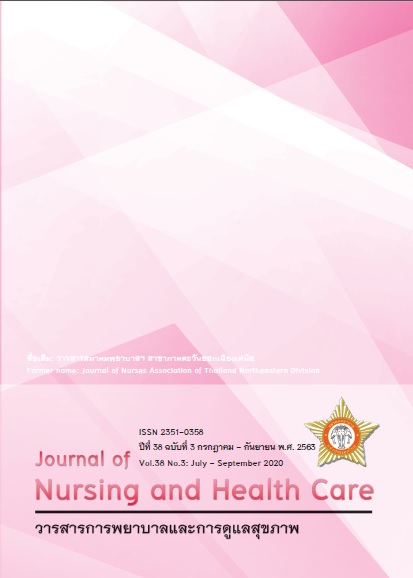ผู้ป่วยจิตเวชตื่นกลัวต่อการถูกผูกยึดเมื่อเข้ารักษาตัวในโรงพยาบาล : บทบาทและการจัดการทางการพยาบาล
คำสำคัญ:
การผูกยึด; ผู้ป่วยตื่นกลัว;การพยาบาลบทคัดย่อ
บทความนี้นำเสนอความรู้สึกของผู้ป่วย การประเมินความรู้สึกของผู้ป่วยและการจัดการ ผู้ป่วยจิตเวชที่มีพฤติกรรมก้าวร้าว ซึ่งมักรู้สึกวิตกกังวลกลัวและกระวนกระวายใจที่ต้องเข้ารักษาตัวในโรงพยาบาล โดยเฉพาะหากมีการผูกยึดเพื่อช่วยลดความรุนแรงที่มักทำให้ผู้ป่วยส่วนใหญ่ไม่พอใจ บุคลากรผู้ช่วยเหลือทางสุขภาพจิตจึงต้องมีทักษะในการประเมินภาวะอันตรายที่ซ่อนอยู่และพยากรณ์แนวโน้มความรุนแรงในอนาคตก่อนการผูกยึดการดูแลทางการพยาบาลที่เหมาะสม เป็นการส่งเสริมการรักษาและคงไว้ซึ่งความปลอดภัยของผู้ป่วย พยาบาลสามารถเรียนรู้จากประสบการณ์ในการดูแลผู้ป่วยที่มีพฤติกรรมก้าวร้าวรุนแรงเพื่อจัดการกับปัญหาทั้งหมดและนำไปสู่มาตรฐานและคุณภาพการพยาบาลจิตเวชอย่างมีประสิทธิภาพ
Downloads
เอกสารอ้างอิง
2. Gallo K, Smith LG Editor.Building a culture of patient safety through simulation An interprofressional learning model. New York; Springer publishing company; 2015.
3. Annamalai J, Gan TS, Xie H, Effectiveness of non-pharmacological interventions to reduce the use of physical restraint in mental health settings: a systematic review protocol. JBP Library. 12 (6);2014. (http://joannabriggslibrary.org/index.php/jbisrir/article/view/1395)
4. Wieman DA, Camacho-Gonsalves T,Huckshorn KA.Leff S. Multisite study of an evidence –based practice to reduce seclusion and restraint in psychiatric inpatient facilities. Psychiatr serv 2014;65(3):345-51.doi:10.1176/appi.ps.201300210.
5. Satikunaporn Dusida. Patient right and decision making on physical restraint and psychiatric nurses. J of Psychiatric-mental health nursing 2014;28(3):1-12. (in Thai)
6. Pukdeemongkul K, Unipun C. Kunthasaibua,P. The Development of primary nursing service: model for schizophrenia patients having violence behavior. J of Psychiatric-Mental Health Nursing. 2005; 20(2):25-38. (in Thai)
7. ANA broad of directors.Reduction-of-Patient-Restraint-and-Seclusion-in-Health-Care-Settings, March 12,2012.-http://www.nursingworld.org/MainMenuCategories/EthicsStandards/Ethics-Position-Statements/Reduction-of-Patient-Restraint-and-Seclusion-in-Health-Care-Settings.
8. Department of mental health, MENTAL HEALTH ACT, B.E. 2551 (2008), 2016. http://www.omhc.dmh.go.th/law/filesweb.pdf (in Thai)
9. APNA position on the use of seclusion and restraint. Revised, 2014. http://www.apna.org/i4a/pages/index.cfm?pageid=3728
10. Department of social service. Australia government. Decision –making tool: handbook-supporting a restraint free environment in residential age care. Ageing and age care -https://www.dss.gov.au/...care/...restraint...care/decision-making-tool-sup. Sep 26, 2014
11. CANHR, Restraint free care. Jan 8, 2015. www.canhr.org/factsheets/nh_fs/html/fs_RestraintFreeCare.htm.
12. Sullivan AM , Bezmen J, Barron CT, Rivera J, Curley-Casey L& Marino D. Reducing Restraints: Alternatives to Restraints on an Inpatient Psychiatric Service—Utilizing Safe and Effective Methods to Evaluate and Treat the Violent Patient. Psychiatric Quarterly 2005;76(1):51-65.
13. Lynda C. Burton, Pearl S. German, Barry W. Rovner, Larry J. Brant, and Rebecca D. Mental Illness and the Use of Restraints in Nursing Homes The gerontologist 2016;32(2):164-170.
14. Barton SA, Johnson MR, Price LV. Achieving restraint-free on an inpatient behavioral health unit. J.Psychosoc Nurs Ment Health Serv 2014;47(1):34-40.
15. Stewart D, Van der Merwe M, Bowers L, Simpson A, Jones J .Review of Interventions to Reduce Mechanical Restraint and Seclusion among Adult Psychiatric Inpatients .Issues in Mental Health Nursing 2010;31(1):413-424.DOI:10.3109/01612840903484113
16. Johnson ME. Violence and Restraint Reduction Efforts on Inpatient Psychiatric Units. Issues in Mental Health Nursing 2010;31(1):181-197. DOI: 10.3109/01612840903276704.



